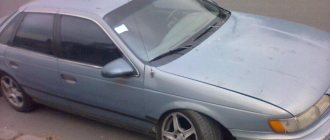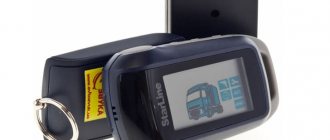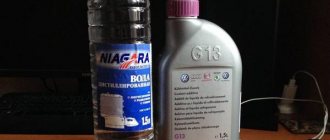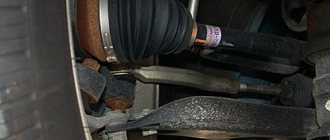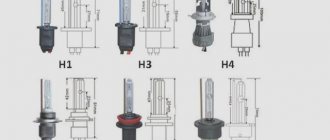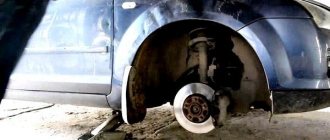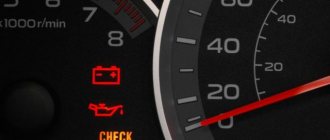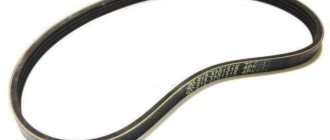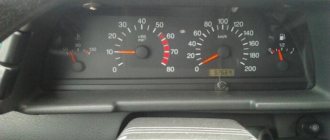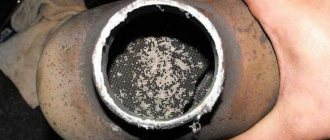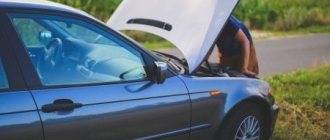We determine which CV joint crunches, the inner or outer one
Several methods are used to diagnose CV joints.
The simplest of them is a visual inspection of the anthers and checking the shafts. The main cause of problems associated with the appearance of crunching is the ingress of dirt into the nodes, which can only occur due to damage to the boot.
If the rubber element is torn, then upon inspection there will be traces of leaking lubricant on it, from which you can understand which of the units got sand and dust.
Also, during inspection, you should try to move the drive shaft in the transverse and longitudinal directions by hand. CV joints are highly precision-manufactured units, and if it feels like they have play, it’s time to take action.
If, during a visual inspection, no leaks in the boot are detected, but symptoms of a joint malfunction appear, several simple methods can be used to identify which of the CV joints is problematic.
Diagnostics of external hinges
External hinges are tested by placing a strong load on them. To do this, simply turn the wheels all the way to the right or left and try to start moving at higher speeds. Afterwards, we carry out the same procedure again, but this time when turning the wheels in the other direction.
When checking CV joints using this method, starting to move with the wheels turning to the left will create a significant load on the right unit, and if it has play, it will begin to crunch.
By turning the wheels to the right, the left hinge is checked. But we note that a crunching noise can also be produced by the outer CV joint on the side where the turn is being made.
Therefore, when checking, it would not be superfluous to have an assistant present, who, being near the car, will establish by ear which side the sound is coming from.
Checking internal components
To determine which inner CV joint is crunching, a different method is used. To carry it out, you need a flat section of the road, but with a bump (hole).
The essence of the test comes down to driving through a hole at a moderate speed with one of the front wheels. Then everything is repeated, but with the second wheel entering the hole.
When a wheel hits a bump, a shock load occurs on the inner joint, and if there is play in it, they will manifest themselves in the form of knocks or soft crunches.
Universal method
The only drawback of the method of driving into a hole at speed is the fact that there is not always a suitable section of road with a bump. Therefore, another method can be used for diagnostics, and it is universal and allows you to check both internal and external CV joints.
POPULAR WITH READERS: Signs of a faulty car suspension support bearing
The algorithm of actions is as follows:
- Use a jack to jack up one of the drive wheels;
- We place a stop under the car and apply the handbrake;
- We start the engine, engage first gear and gradually release the clutch pedal (we simulate the beginning of movement. At the same time, thanks to the differential, the suspended wheel will begin to rotate, and the one standing on the ground will remain motionless);
- Having gained engine speed, we begin to slow down the rotating wheel with the brakes (we do not touch the clutch pedal. Thus, with the brake mechanisms we create a load on the internal unit, and if it is problematic, it will immediately manifest itself with knocks and crunches);
- After checking the internal hinge, we determine the condition of the external one. To do this, just release the brake pedal, pick up speed, turn the wheels all the way to one side and use the brakes again. A large drive angle and brake force will create the necessary load, which will cause the external assembly to crunch if it is not working properly.
After checking on one side, we repeat similar work with the drive of the second wheel.
What is CV joint
CV joint ford focus 2
The principle of operation of a CV joint is similar to the operation of a cardan. However, the lifespan of grenades is longer, and the permissible rotation angles reach 70 degrees. They work in pairs. Each wheel axle has an inner and outer CV joint.
- External - connected to the wheel hub, through it it transmits movement to the wheel.
- Internal - inserted into the gearbox, it transmits movement from it to its external counterpart.
External bearings break more often; they take the blows coming from the wheels. The rubber casing that protects the grenade from water and dirt is the first to be destroyed. Then the lubricant leaks out and the joint becomes clogged with dirt and water. As a result, the parts of the mechanism break and a crunching sound occurs.
Failure of the inner CV joint occurs less frequently. It takes less load and works at smaller angles. If it breaks, it can cause damage to the transmission, increasing the cost of repairs.
Where is the grenade located in the car?
Let us repeat that this spare part is only available for front-wheel drive cars. Cars with rear drive wheels are driven by another shaft - a cardan. Therefore, the answer to the question of what a grenade is and where it is located in the car is relevant only for the first case.
The grenades are located in the front of the car. Each car contains 4 grenades: two per wheel. This is necessary so that the suspension can normally raise and lower the wheel on bumps and still steer. It is quite easy to identify them visually by their corrugated rubber boots.
Usually the anthers are black, but you can find brown-red or transparent models
The first grant in a pair is inserted into the wheel hub and is called the outer one. She is responsible for moving the wheel up and down and for turning it left and right. This unit experiences the heaviest loads, and therefore is manufactured in a fairly large size.
The second joint is inserted into the transmission and is called the inner joint. Its task is to ensure that the wheel moves slightly up and down on uneven surfaces. The load on it is less, and therefore the size is more modest.
The left joint is stuck into the wheel hub, and the right one into the gearbox output. Between them is the axle shaft
The outer and inner grenades are connected to each other by an axle shaft with longitudinal slots. It is this composite structure, consisting of three parts, that ensures the transmission of torque from the engine to the wheels.
Video about the CV joint, its disassembly and the reasons for the crunching
Video about the structure and principle of operation of the grenade
Consequences of a CV joint crunch
Is it possible to drive without antifreeze?
Is it possible to drive with a CV joint crunching? It all depends on the degree of wear and tear. At the initial stage of the breakdown, you can drive, but it is not advisable, since the operation of the unit leads to even greater damage. Therefore, the sooner you try to repair the hinge, the, firstly, it will cost you less (perhaps everything will cost you by replacing the lubricant), and secondly, you will not put the life and health of you and your passengers in the car at risk.
So, the consequences of a CV joint crunching can be:
- Jamming. That is, the CV joint will stop rotating. This is especially dangerous at speed, as you risk losing control of the car, which can be fatal. You can try to wedge the hinge, but the best solution is to replace it.
- Clip break. If we talk specifically about an external grenade, then when it comes to the wedge, the clip simply breaks, the balls scatter, and then the consequences are unpredictable.
- Rupture of the shaft or axle shaft. In this case, the gearbox will turn only the designated parts, but for obvious reasons the torque will not be transmitted to the drive wheel. This is the most extreme case, and further movement of the car is possible only with a tow truck or tow truck. Naturally, the only correct solution in this case will be to replace the CV joint. And you will be lucky if you only have to change the hinge itself. After all, there is a risk that other parts nearby will be damaged during this accident.
In the worst case scenario, the CV joint can jam or break, which will lead to an emergency on the road. When this happens at speed, it is fraught with serious consequences! Therefore, if you hear that a “grenade” is crunching on any side of your car, carry out diagnostics as quickly as possible (on your own or at a service station) and repair or replace the hinge.
Replacement and repair
If there are problems with the CV joint, it must be repaired. This work is quite difficult, so if you are not confident in your abilities, then it is better to entrust the work to specialists. When carrying out all work, you should do it as carefully as possible and in accordance with the instructions.
Please note the condition of the item. If there is a large hole, then restoring the CV joint is impractical; it is better to replace it as an assembly
The work to put the part in order is carried out as follows:
The CV joint is removed. Be careful. Sometimes you have to knock him down
This should be done as carefully as possible; The dismantled hinge is clamped in a vice. The part is turned all the way, the balls are removed
To do this, knock them out using a screwdriver; The separator is installed vertically, after which it is rotated to the position where the windows intersect with the end; Next, remove the fist with the separator; to do this, rotate the fist until the moment when you can recess the fastening protrusion into one of the windows.
Inspect all hinge elements. There should be no damage to them, no signs of wear or deformation. If there are doubts about the quality of the part, it is better to replace the CV joint. You shouldn't skimp on your safety. Assembly should begin with lubricating the parts. It is important to carry out this work as efficiently as possible; the future service life of the hinge depends on it; The balls are placed in the CV joint in pairs, as they were located before; Grease is again applied on top of them; The last step will be installing the boot. You should also put 50-100 grams of lubricant in it.
The quality of CV joint restoration depends on the correct installation of the balls and the presence of lubricant. It is better to use CV joint-4 as a lubricant, but in extreme cases LITOL-24 will also work. Actually, the main quality that affects the service life of the hinge is the abundance of lubricant. This way you can significantly reduce the level of wear on the part and, accordingly, prolong its operation.
Conclusion
. CV joints are one of the important elements in a car transmission. They allow optimal transmission of force to the wheels. To avoid problems, it is advisable to know all the signs of a faulty inner CV joint. This knowledge will allow you to identify the malfunction in a timely manner. If a breakdown is detected, it should be repaired as soon as possible. This will increase the level of safety when driving.
Types of CV joints
Is it possible to drive with a hernia (bump) on a wheel?
During its existence, the design of the internal CV joint and its external version has been modified several times. Previous hinge models remained in use along with new developments. Today there are 4 main hinge designs known.
- Cam (cracker). Consist of 2 shaped discs and a similar number of forks. Due to the large adhesion area, they are able to withstand intense loads, but are not without significant design flaws. Vehicles equipped with cam joints can only be driven at low speeds. Otherwise, the unit heats up and fails. The cracker type device is common in freight transport.
- Tripod. This type of hinge consists of 3 rollers, which are placed in a special bowl. The transfer of angular momentum occurs due to the displacement of the rollers. These types of CV joints are used for small cars. Some passenger cars and vehicles not designed for transporting heavy loads ride on a tripod.
- Cardan shafts are paired. In fact, they are a pair of cardan joints, due to mutual rotation, equalizing each other’s operating speed. Such designs were actively used in the American automotive industry in the 20s of the last century. Today, some models of construction equipment and tractors are equipped with twin hinges.
- Ball. This node model is the most common. The hinge consists of a body, a separator, a cage and 6 balls. The latter move along oblique grooves on the inner surface of the outer race, thereby ensuring torque transmission.
There are also intermediate models of the unit: four-ball, rigid tripods. However, they are not widely used because they are not very reliable and perfect.
The CV joint crunches at low temperatures, what to do?
As a rule, at low temperatures, the cause of crunching of CV joints is poor-quality lubricant, which is not able to perform its functions in extreme cold.
Car manufacturers, when supplying their products to Russia, must take into account the operating conditions.
The frozen lubricant binds the internal elements of the grenade and does not get into all the cavities of the assembly, which is why the crunch appears.
At this moment there is no need to turn sharply and pick up speed; after a few kilometers (20-30) the components will warm up and the crunching will disappear by itself.
But the problem is that the internal grenades warm up quickly, but the external ones at very low temperatures may not warm up and the crunch will remain.
There is an opinion (and not without reason) that the problem is not only in the lubrication, but also in the design of the CV joint itself. The fact is that the lubricant put into the product may not be suitable for this design, while on other car models it works well even at temperatures below -20 C.
Some car owners are guilty of using polyurethane boots, which can be installed on some brands of cars instead of rubber ones. They say that in the cold they tan and make sounds. This is a controversial opinion that requires verification.
The problem can be solved by replacing the lubricant; some car owners recommend LM47, VERYLUBE, XADO, they performed well at low temperatures. But it’s difficult to give any advice here, the choice on the market is huge and opinions vary.
But, you need to change the lubricant not just by pressing it under the boot, but completely remove the assembly, disassemble it and press the new lubricant as much as possible instead of the old one into hard-to-reach places. It is these places that cause crunching in severe frost, especially for external grenades.
Elimination of crunches and knocks, restoring the operation of CV joints
How to find out which CV joint is crunching - we figured it out, now about the measures that should be taken to fix the problem, since it is undesirable to operate a car with problematic joints.
One of the disadvantages of CV joints is their non-repairability, that is, if the joint crunches, then it is worn out and requires replacement. The only thing that can be done is to “extend the life” of the node and delay its replacement.
Since the main reason for the appearance of crunches is dust and dirt, when they appear, you should immediately inspect all the anthers for damage. If none are found, we determine which CV joint is crunching using one of the above methods.
POPULAR WITH READERS: Replacing the ball joint Citroen C4, video instructions
After identifying the problematic hinge, we try to extend its service life. To do this you need:
- Remove the drive from the car;
- Disassemble the CV joint;
- Thoroughly wash all components with gasoline, solvent or other means (white spirit, etc.);
- Apply new CV joint grease or equivalents (see above) and assemble the hinge;
- Install a new boot;
- Install the rebuilt drive on the car.
At the initial stage of wear, these measures are enough to get rid of the crunches, but they will eventually return (when the wear intensifies) and then the hinge will have to be replaced.
Main CV joint malfunctions and service life
The CV joint design itself is reliable, a high-quality manufactured part can easily serve for at least 100-150 thousand km. However, in practice, in many cases, CV joints fail much earlier.
The fact is that the “grenade” in the car has a boot (often rubber). The mechanism can also be protected by a silicone boot (cover). One way or another, the boot is needed to cover the balls and grooves from sand, water, dirt, reagents from the road, etc.
Taking into account this information, it is recommended to inspect the CV joint boots as carefully as possible at each maintenance. If any defects are noticed (cracks, tears, unreliable fixation and displacement of the boot), then the boot must be replaced without fail, following all the rules for its installation.
Finally, we note that during repairs it is recommended to replace the CV joint with an original spare part or a high-quality analogue, since cheap substitutes from unknown manufacturers are usually made of low-quality materials and have a short service life.
How an automatic transmission works: classic hydromechanical automatic transmission, components, controls, mechanical part. Pros and cons of this type of gearbox.
Why the automatic transmission kicks, the automatic transmission jerks when changing gears, jerks, jerks and impacts occur in the automatic transmission: the main reasons.
Connecting the gearbox and car engine
Connecting a manual and automatic transmission with an internal combustion engine: what to look for, features and nuances
Design and principle of operation of a robotic gearbox. Differences between robotic gearboxes and torque converter automatic transmissions and CVT variators.
AMT gearbox: design and operation of a robotic gearbox, types of robotic gearboxes. Advantages and disadvantages of robotic transmission.
Automatic transmission (automatic transmission, automatic transmission) of the “classic” type with a torque converter: device and principle of operation. Pros and cons of hydromechanical automatic transmission.
Signs of a faulty steering mechanism
The first time after purchasing a car, novice drivers pay more attention to the road situation, without really listening to the behavior of the car. The skill of keeping an eye on the road and feeling the car only comes with time.
This skill is very important because it allows a possible malfunction to be identified at an early stage, which can not only significantly reduce the cost of repairs, but also affect safety. Yes, and it is not always possible to contact the service for diagnostics.
Any car consists of many components and mechanisms, and problems can arise with each of them. Moreover, a number of components of the car are responsible for safety during movement, so their condition must be monitored first. These components include the steering mechanism.
Detailed diagram of the steering mechanism of the VAZ 2114
Most malfunctions in cars are accompanied by the appearance of third-party sounds - noises, squeals, knocks. And an experienced driver is able to determine, when they appear, which unit has problems. But for example, not every experienced driver is able to identify the cause of a knock when pressing the brake or gas pedal.
The main sign of problems with the steering mechanism is also the appearance of third-party sounds. Most often, the knocking occurs when the steering wheel is turned either in one or both directions.
Although it is worth noting that this is not always the case, the fault may also be with another component of the car, located next to the steering mechanism.
A knock in the steering mechanism is not a problem for certain car brands; it can appear in the Soviet-made VAZ-2106, in the new domestic Kalina, and in cars from European and Asian manufacturers.
Of course, the likelihood of such a problem occurring in a foreign brand car is somewhat lower than in Kalina, but it does exist.
The fault is often due to poor quality assembly of the car. The same VAZ “Kalina” is already structurally approaching foreign cars, but its assembly is still “lame”.
But Kalina and other cars from VAZ are still in demand, because their price is an order of magnitude lower than in Europe.
Therefore, a large segment of cars on our roads is occupied by domestically produced models.
Exit from the yard is blocked
If your car is blocked in the yard by a car belonging to neighbors or other people, you should not take rash actions and panic, even if you are late for an important meeting or work.
In such a situation, people most often get locked up by acquaintances (neighbors), whom it is easy to contact in person, informing them that your vehicle is locked in the yard and it is necessary to clear the passage. Most neighbors and their vehicles are known, so there is no question of who to contact. The problem will be quickly resolved without scandals and conflicts, since the culprit is not interested in inciting a quarrel.
However, such issues are not always resolved so easily. If the neighbor is absent or the car turns out to be of unknown origin, you will have to wait until the driver arrives at the place and clears the passage.
Many are tempted to pretend that they did not notice the interference and hit the car, scratching the body. This will force the owner to spend time obtaining insurance and compensation for damage. But you shouldn’t act so rashly. A moment of moral satisfaction will result in claims from the neighbor, especially since there will always be witnesses to the incident and well-wishers in the yard who will inform him about the culprit of the defect.
In such a situation, the driver who blocked the car only faces the imposition of a small administrative fine in the amount of three hundred rubles, and the one who caused the damage will have to reimburse the funds spent on car repairs.
In this case, it is much easier to report the problem to the traffic police, and the issue will be resolved in the manner described above, which will allow you to leave the yard without breaking the law and avoiding trouble.
Reasons causing breakdown
CV joint malfunctions can occur for a variety of reasons, for example, when hitting a curb, falling into a hole, etc. However, most often this unit fails due to banal damage to the boot.
The boot (corrugated rubber or silicone cover) protects the CV joint parts from dust, dirt, moisture, etc. In addition, to increase service life, the CV joint boot is filled with a special liquid lubricant made on the basis of barium. The lubricant envelops the surfaces of parts and must maintain its properties in the temperature range from -30 to 160°C.
Structurally, a CV joint is the same bearing, only a little more complex, and the ingress of abrasive particles or moisture has a negative impact on the external surfaces of friction parts. When exposed to negative factors, the parts of friction pairs wear out faster, traces of wear appear on them and backlash occurs. If abrasive particles get into the lubricant, the latter can be pressed between the rubbing parts, which also contributes to their accelerated wear.
When the boot ruptures, the tightness of the space in which the CV joint operates is broken and, under the influence of the environment, the unit very quickly fails. As a rule, a malfunction of the grenade does not lead to a catastrophic accident, but it may well create a situation where the trip will be continued on a tow truck.
The only way to avoid a “grenade” breaking due to a torn boot is a preventive inspection of their locations. If even slight damage is detected, it is necessary to replace the boot as quickly as possible. After all, even through a minor puncture, the lubricant will be displaced, which will lead to a decrease in its quantity and, ultimately, to increased wear of the CV joint parts.
Types of CV joints, their design features
The most common types of CV joints in the design of front-wheel drive passenger cars are ball and tripoid.
The former are often used on the outside, the latter as internal hinges. On some models, ball devices may also be installed exclusively.
The design of these types of CV joints differs, and significantly. The tripoid assembly consists of an outer casing of a certain shape, on which there is a drive shaft end stop (thanks to it, the drive is connected to the gearbox).
The housing contains a tripoid with rollers, mounted via a splined connection on the drive shaft.
Ball CV joints are partially similar in design to conventional bearings - there are two cages between which the balls are located in the separator.
The outer ring of the unit is its body, on which another shaft end is attached (it is installed in the wheel hub). The inner race is mounted on the drive shaft by means of a spline connection.
The transfer of force from the inner race to the outer one in such a hinge is carried out by balls, which are located in special grooves on the working surfaces of the races.
These same grooves allow the balls to move longitudinally, thereby ensuring transmission of rotation when the drive shaft and end switch are positioned at an angle relative to each other.
A tripoid CV joint is structurally simpler, and therefore more reliable, but it is used only as an internal hinge. This is due to its operational characteristics - they allow significant longitudinal movements of the tripoid relative to the body (provides a change in the length of the drive), but at the same time it is limited in the angle of rotation of the limit switch relative to the shaft.
In ball joints, the angle of rotation is much larger, so it is better suited for use on the outside of the drive, but such a unit does not provide significant longitudinal movements.
Due to their more complex design, very harsh operating conditions and location (near the wheel), ball CV joints are more susceptible to wear and malfunction; they are smaller in size than their tripod counterparts.
Both types of CV joints are made with high precision, so there are no backlashes in them. But during the operation of the car, the working surfaces of the hinge gradually wear out, which leads to the appearance of backlashes, which are the main cause of unit failure. The wear situation is aggravated by dirt getting inside the joint.
As already noted, CV joints are quite reliable and can last a significant period of time, provided they are used correctly. These hinges are very sensitive to dirt. Dust and sand trapped inside the unit act as an abrasive, significantly accelerating the wear of working surfaces.
Anthers are used to protect the hinges from dirt. But these rubber elements are the “weak point” of CV joints.
POPULAR WITH READERS: How to install air suspension with your own hands
Rubber tears relatively easily; it is affected by the environment, leading to “aging” and cracking of the material. The anthers of the external hinges are especially susceptible to negative influences.
Types and design of CV joints
Before we move on directly to describing the signs and causes that indicate problems with CV joints, we need to find out what they are for and what they are. This will make it easier for you to understand how to diagnose and repair them in the future.
Types and location of CV joints
The job of any constant velocity joint is to transmit torque between the axle shafts when they are at different angles at different times. CV joints are used in front-wheel drive and all-wheel drive vehicles to allow the front wheel to turn and rotate under load. There are several types of hinges, but we will not dwell on this in detail. It is important to know that, basically, they are divided into internal and external . Any front-wheel drive car has only four CV joints - two internal and two external, in pairs on each front wheel. The task of the internal one is to transmit torque from the gearbox to the shaft. The task of the external one is to transmit torque from the internal joint directly to the wheel.
a tripod inserted into it - a set of needle bearings operating in three planes. The main shaft (from the “glass” side) is inserted into the gearbox, and another axle shaft is inserted into the tripod, to which torque is transmitted. That is, the design of the internal CV joint is simple, and, as a rule, problems with it arise infrequently. The only mandatory condition for the normal operation of the hinge (this also applies to the external “grenade”) is the presence of lubricant inside it and the integrity of the boot. You can read about choosing a lubricant in a separate article.
Inner and outer CV joints paired
The outer CV joint is a more complex and fragile structure. On one side it is connected to the internal hinge through the axle shaft, and on the other - directly to the hub through its own splined shaft. The design of the outer hinge is based on a ball cage . It can rotate within the angular ranges specified by the design. It is the ball mechanism that is most often the reason why the CV joint crunches. A boot is placed on the body of the external “grenade”, which reliably protects the insides from dust and dirt. The normal operation of the device directly depends on this, and according to statistics, it is a torn boot that is the root cause of the complete or partial failure of this mechanism.
To extend the service life of the outer CV joint, you need to adhere to two simple rules: regularly check the integrity of the boot and the presence of a sufficient amount of lubricant in it, and also try not to “accelerate” with the wheels turned too far, since in this case the joint experiences maximum loads, which leads to its excessive wear and tear
Operation of the outer CV joint
Remember that any constant velocity joint experiences greater loads the greater the angle at which its two axle shafts operate. If they are parallel to each other, then the load on the node is minimal; accordingly, at a maximum angle, the load will be maximum. It is thanks to this property that a faulty hinge can be identified, which we will talk about next.
The CV joint is crunching - how to determine which one, and what to do?
Hello, dear motorists! A car enthusiast can only consider himself a real car owner when he is truly concerned about the condition of the car’s components and assemblies, and every new knock, creaking and other signs of car breakdowns haunt him.
Driving a car can be called comfortable only if all elements are in good working order.
However, each part, especially those that operate under load and friction like a CV joint, has its own working life.
Sooner or later, the material wears out and loses its properties, which leads to failure of the part. This is objective. And a “hint” about an impending breakdown from the part itself must be taken seriously. It’s better not to wait for the car to stop on a long journey, but to immediately begin troubleshooting and fixing it.
Owners of front-wheel drive cars are familiar with such an unpleasant phenomenon as a CV joint crunching. Considering that the front suspension of the car, in addition to its main functions, must also ensure the transmission of rotation from the differential gears to the drive wheels, it is equipped with unique devices: constant velocity joints, which in its abbreviated version sounds like “CV joint”.
This part is very important and quite complex in design; therefore, it is expensive and requires increased attention. If the CV joint crunches, then without any hesitation you need to take the car in for repairs and change it.
Why does the CV joint crunch?
Video of replacing the outer left CV joint
Experienced drivers are able to determine the location of a car breakdown by ear. Such skills are acquired over time, but the crunch of a CV joint cannot be confused with anything.
In order to understand the nature of this characteristic noise, you should remember how the CV joint is designed. The task of the CV joint is the transmission of rotation from one axle shaft to another, provided that the angle between them continuously changes.
This property is due to the need not only to rotate the drive wheel, but also to give it the ability to turn and move up and down on a spring.
The CV joint consists of the following main elements:
- outer body in the form of a bowl with six semicircular grooves inside and a semi-axis outside;
- the inner race is in the form of a spherical fist and also has six grooves and a splined connection for the axle shaft;
- Between the inner walls of the bowl and the holder there are 6 balls in the separator.
All elements are made so precisely that they have no play when assembled. The cage transmits force through the balls to the body and rotates it, and moving the balls along the grooves makes it possible to change the angle between the axle shafts.
Over time, a hole forms at the point where the balls come into contact with other elements and a backlash appears. The free movement of the balls (rolling) generates a sound that is very similar to crunching.
Considering that CV joints are installed two on each wheel, when alarming symptoms appear, it becomes difficult to find out which CV joint is crunching: inner or outer, right or left.
How to determine which CV joint is crunching: external or internal, right or left?
As you know, each drive wheel of a front-wheel drive car has two equal angular velocity joints: the inner one transmits rotation from the differential gears to the axle, and the outer one directly from the axle to the wheel hub. The outer and inner CV joints have the same design, but different sizes. The outer one wears out more intensively and fails faster.
You can determine for yourself which CV joint is crunching in two ways:
- on a stationary car, trying to pull the axle one by one at the hinges. In a working CV joint there should be no play. If it knocks, it means the output is already large enough;
- in motion, performing various maneuvers and listening to the sounds made.
First you should try to diagnose the outer CV joints. To do this, turn the steering wheel as much as possible while moving on a flat surface in one direction, and then in the other.
If the CV joint knocks when turning to the right, then, accordingly, the right one is faulty, and when turning to the left, the left one is faulty.
The wear of the inner CV joint is determined during straight-line movement, but it is necessary to deliberately select an uneven section of the road, where there will be a ditch or hole, so that the wheel drops as low as possible while moving.
By driving the right and left wheels alternately into the recess, you can determine which side of the CV joint requires replacement. And of course, after you diagnose which one is crunching, immediately begin replacing the CV joint.
The design and principle of operation of the CV joint
First of all, the hinge is designed to transmit driving force from the engine to the wheels of the car. The second important function is to maintain movement at different wheel planes. In simple words, when driving over a bump or hole, one of the wheels will be located higher than the second, while the movement of the car will remain unchanged. The complex design allows the wheels to move in different positions. The operating principle of each type of hinge is the same, only the design is different. The grenade can rotate at an angle of up to 70 degrees, while transmitting rotational motion to the wheels.
There is no fundamental difference in the operation scheme of the CV joint. One part of the drive is attached to the engine using a wheel bearing, the second is connected to the wheels. When the gear is engaged, the engine transmits movement through the transmission, and the car moves. Each CV joint consists of an internal and external part. Inside the structure there are special balls that connect the two elements into a rigid structure. The outer part is more mobile and can work at angles up to 70 degrees. The internal element operates within 20 degrees.
Lubrication is important in the operation of a grenade. All internal parts move at high speeds, so good lubrication can reduce friction and wear on structural elements
As a rule, each hinge is covered with a rubber cap to prevent dirt from getting inside. It is worth noting that rubber protection is of great importance in the operation of the mechanism. If the boot is damaged, the lubricant comes out, dirt gets on important elements and the hinge fails.
External CV joint
The external hinge is very easy to identify visually. It is located near the drive wheel, as a rule, equipped with an ABS system polyhedron and a large pyramid-shaped rubber boot. As we have already written, the boot protects the grenade from moisture, dirt and dust.
The design of the CV joint is somewhat reminiscent of a driveshaft. But the latter, due to its design, cannot rotate at critical angles. This is due to the fact that the operating angle of the cardan transmission is very small, and at critical angles jerks begin, which have a detrimental effect on the gearbox.
A completely different matter is the CV joint. The design allows for a small-sized mechanism that will rotate the wheel in different planes, while maintaining a smooth ride and a comfortable ride.
The external “grenade” consists of a body and axle shaft, as well as a protective casing. There are metal bearings (balls) inside the mechanism. All structural elements are connected to each other using a metal ring. The principle of operation is simple, the mechanism rotates in different directions, the balls rotate inside the body in special grooves, and a smooth transmission of rotational motion occurs.
Inner CV joint
In some cases, the design of the internal “grenade” may be similar to the external one. But, as a rule, developers implement a different scheme. If the CV joint moves with the help of three bearings, it is called tripoidal. As practice shows, such a mechanism breaks down much less often. This is due to the fact that it is less subject to critical loads and changes in angles, since it is closer to the differential, that is, to the center of the car. Depending on the design, it may consist of balls of different sizes and diameters.
The principle of operation is similar to the external grenade, only due to the design features and location, the internal hinge operates at smaller degree ranges. Typically, the working angle is up to 20 degrees.
Video of the operation of the outer and inner CV joints on the drive shaft.
How to repair a CV joint
Damage to the internal parts of the hinge most often leads to a complete replacement of the mechanism. However, this only happens with significant wear. In most cases, it is recommended to simply replace the CV joint grease and boot. This is often enough to get rid of the annoying sound and make it easier for the parts to interact.
Therefore, if knocking or clicking sounds appear on one of the four CV joints (we will assume that you have already found out which one), you must perform the following steps:
New inner CV joint
- Drive the car into the inspection pit in order to check the integrity of the boots and the presence of lubricant splashes from under them on nearby surfaces.
- If traces of grease are visible on the boot or other parts, it is necessary to remove the CV joint. Next, disassemble it, remove the boot, wash the internal parts and surfaces, change the lubricant and boot.
- If during the inspection process you find significant play and/or damage to the working surfaces of the parts, you can try to polish them. However, as practice shows, this procedure is ineffective, since you cannot eliminate significant waste with anything. Therefore, the best recommendation would be to completely replace the CV joint.
You can replace the lubricant and boot yourself, as the procedure is simple. The main thing is, when disassembling, do not forget to wash all internal parts and surfaces with gasoline, thinner or other cleaning liquid. And only then apply new lubricant. However, if you are dismantling and replacing the lubricant for the first time, then it is better to have a more experienced car owner or technician with you. Or have him perform the procedure and show you its algorithm. In the future, you can easily cope with such work.
Conclusion
Constant velocity joints are reliable and durable mechanisms. However, during operation, it is necessary to constantly monitor their condition in order to determine in time which CV joint is crunching or making other unpleasant sounds. After all, this indicates a malfunction in its operation. Hinge failure at the initial stage is not critical. You can drive hundreds or even a thousand kilometers with a crunch. However, you should remember that the sooner you repair or replace the CV joint, the cheaper it will cost you. In addition, do not forget about safety. Do not bring the condition of the hinge to a critical level, as this may result in a serious emergency situation, especially at high speed. We hope that the above information helped you figure out what to do when the CV joint crunches and accurately determine which one is faulty.
How the inner CV joint crunches
Inner CV joint design
Internal hinges are diagnosed differently. To determine which CV joint is faulty, left or right, you need to find a straight road with significant potholes and drive along it. If the hinge is broken, it will “knock.”
Let us describe another interesting method for determining how the inner CV joint crunches, which consists in not hanging the wheels, but significantly making the rear part of the car heavier (put a lot of people in, load the trunk), that is, make the front of the car rise and the axle of the inner CV joint curved as much as possible. If in this position you hear a crunching sound while moving, then this is one of the signs of a malfunction of the mentioned unit.
During standard operation of the car, it is not recommended to constantly drive with the front of the car raised high, that is, do not heavily load the rear of the car. Keep an eye on the shock absorber springs and spacers.
Is the CV joint really to blame?
As soon as you hear a crunching sound in your car, you should not draw any clear conclusions, because the source may be some other component. The involvement of constant velocity joints can be determined in two ways.
Turn the wheels of your car all the way to the side, and then try to drive off in this position. If in this particular situation a crunching sound is heard, then the problem is really in the hinges. This problem can also occur when overcoming small obstacles, for example, potholes on a country road. There will be increased stress on the CV joints and you should hear crunching sounds.
A little about the nature of the problem
A CV joint is necessary to transmit rotation between the axle shafts with a constant change in the angle between them. The part is used in front-wheel drive and all-wheel drive vehicles. The drive wheel in such cars must not only rotate, but also turn, and also lower and rise on a spring. Such hinges allow you to do all this.
The design of this unit consists of three main components:
- The outer housing, which is made in the shape of a bowl and is connected to the axle shaft.
- Inner ring. It has a spherical shape. There are six grooves on it, thanks to which the clip is attached to the outer casing.
- Six small balls in the separator. They are located between the bowl holder and the machines.
The problem is that during operation, with the constant “walking” of the balls in the structure, wear and small scuffs form. The movement of the balls becomes more free, which leads to a characteristic sound. Even inexperienced drivers will be able to determine the presence of this problem. You may hear clicking sounds accompanied by vibration or whistling. In most cases, the sound will resemble the crunching of metal.
Checking the serviceability of the CV joint
Malfunctions of the internal and external CV joints manifest themselves in different ways. To check the external hinge, you need to turn the steering wheel as far as possible and slowly drive around the site. With this position of the steering wheel, maximum bending is formed between the axle shafts. In this case, a faulty outer CV joint will produce a crunching sound, depending on the speed of movement.
Diagnostics of the serviceability of the CV joint. Video:
Achieving maximum curvature of the internal joint is more difficult. To do this you need to do the following operations:
- hang the wheels by lifting the car with a jack or lift;
- start the engine;
- turn on the transmission.
In this position, the faulty internal hinge will make a distinct crunching sound.
How to check the CV joint on a VAZ 2109 and 2114, 2110
A standard test and determination “by ear” does not always make it possible to accurately determine the serviceability of the hinges. Before buying expensive parts, you need to find out and make sure that the problem lies precisely in them. To do this, perform the following operations:
- Place the car on the pit and hang the wheels;
- inspect the condition of the anthers;
- check the play between the axle shafts.
How to check the CV joint on a Renault Logan
The breakdown of parts is indicated by a characteristic crunch (sound) and play of the axle shafts.
Types of CV joints, their design features
The most common types of CV joints in the design of front-wheel drive passenger cars are ball and tripoid.
The former are often used on the outside, the latter as internal hinges. On some models, ball devices may also be installed exclusively.
The design of these types of CV joints differs, and significantly. The tripoid assembly consists of an outer casing of a certain shape, on which there is a drive shaft end stop (thanks to it, the drive is connected to the gearbox).
The housing contains a tripoid with rollers, mounted via a splined connection on the drive shaft.
Ball CV joints are partially similar in design to conventional bearings - there are two cages between which the balls are located in the separator.
The outer ring of the unit is its body, on which another shaft end is attached (it is installed in the wheel hub). The inner race is mounted on the drive shaft by means of a spline connection.
The transfer of force from the inner race to the outer one in such a hinge is carried out by balls, which are located in special grooves on the working surfaces of the races.
These same grooves allow the balls to move longitudinally, thereby ensuring transmission of rotation when the drive shaft and end switch are positioned at an angle relative to each other.
A tripoid CV joint is structurally simpler, and therefore more reliable, but it is used only as an internal hinge. This is due to its operational characteristics - they allow significant longitudinal movements of the tripoid relative to the body (provides a change in the length of the drive), but at the same time it is limited in the angle of rotation of the limit switch relative to the shaft.
In ball joints, the angle of rotation is much larger, so it is better suited for use on the outside of the drive, but such a unit does not provide significant longitudinal movements.
Due to their more complex design, very harsh operating conditions and location (near the wheel), ball CV joints are more susceptible to wear and malfunction; they are smaller in size than their tripod counterparts.
Both types of CV joints are made with high precision, so there are no backlashes in them. But during the operation of the car, the working surfaces of the hinge gradually wear out, which leads to the appearance of backlashes, which are the main cause of unit failure. The wear situation is aggravated by dirt getting inside the joint.
As already noted, CV joints are quite reliable and can last a significant period of time, provided they are used correctly. These hinges are very sensitive to dirt. Dust and sand trapped inside the unit act as an abrasive, significantly accelerating the wear of working surfaces.
Anthers are used to protect the hinges from dirt. But these rubber elements are the “weak point” of CV joints.
Rubber tears relatively easily; it is affected by the environment, leading to “aging” and cracking of the material. The anthers of the external hinges are especially susceptible to negative influences.
Prevention of CV joint failures
Inner CV joint boot
First of all, you need to monitor the condition of the rubber covers of the CV joints. In general, the manufacturer, as a rule, prescribes replacing the hinges themselves if their covers are damaged. But in practice, if the “grenade” has not yet “picked up” sand and water, sometimes it is possible to get by by thoroughly washing it and replacing the lubricant.
The manufacturer, as a rule, prescribes replacing the hinges themselves if their covers are damaged.
You also need to pay attention to how tightly the clamps on the covers are fastened. A correctly tightened clamp does not allow the boot to rotate on the hinge body
In general, make it a rule to pay attention to the condition of the covers (they are often called boots) in every suitable case - when you change a wheel, or you can ask them to be examined at a car service center where you went to change the oil. Despite the fact that we examined the operation of the hinge, using the VAZ drive as a sample, the principle of operation of such units is quite similar, even if your car is not equipped with the “usual” CV joint, discussed above, but a tripod, which is often installed as an internal hinge.
Why does the CV joint crunch?
While operating the car, the driver sometimes hears a faint crunching sound - the crunch of a grenade. This usually becomes noticeable when the wheels are turned to the maximum angle.
Why does the CV joint crunch? What to do in such a situation?
A crunch is evidence of a unit malfunction. Initially appearing only when the wheels are turned, later it begins to appear during straight-line movement. Extraneous sounds produced by the hinge require its replacement.
If you perform the diagnostics yourself, you should hang up the front wheels of the car and inspect the boots. Crisp grenades can be identified by their damage.
The fact is that the cause of the crunching is usually dust and grains of sand that get into the hinge through breaks in the rubber cap. Also, a malfunction can be suspected of a unit on which greater play was detected than on all other hinges.

